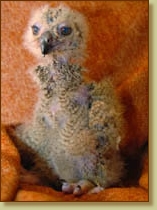 | |||||||||||||||||||||||||||||||||||||||||||||||||||||||||||||||||||||||||||||
 |  | ||||||||||||||||||||||||||||||||||||||||||||||||||||||||||||||||||||||||||||
 | |||||||||||||||||||||||||||||||||||||||||||||||||||||||||||||||||||||||||||||
Snowy Owl, Nyctea scandiaca A male (left) and a female (right). What beautiful birds. The owners say they don't seem to like the cold! | |||||||||||||||||||||||||||||||||||||||||||||||||||||||||||||||||||||||||||||
Bengal Eagle Owl, Bubo bengalensis Another very beautiful owl. The landscape pics above are large-screen screensaver size (1280 x 960, 250 kb). For smaller versions click on the small thumbnails below. Below left: a delightful lady with her egg. | |||||||||||||||||||||||||||||||||||||||||||||||||||||||||||||||||||||||||||||
 | |||||||||||||||||||||||||||||||||||||||||||||||||||||||||||||||||||||||||||||
24 March 2007 Some pics of recently hatched captive-bred Bengal owlets have been posted by Diane from Norfolk on an Owl Pages thread. Click here or on thumbnail. That's Juicy on the right, shown at about 3 weeks. Merlin, the other chick, is a week younger. More pics of a Bengal owlet on Owl Gallery page 6, about half way down. | |||||||||||||||||||||||||||||||||||||||||||||||||||||||||||||||||||||||||||||
Here are 1024 x 768 pixel versions of the two pics at top left. | |||||||||||||||||||||||||||||||||||||||||||||||||||||||||||||||||||||||||||||
Spotted (or African) Eagle Owl, Bubo africanus | |||||||||||||||||||||||||||||||||||||||||||||||||||||||||||||||||||||||||||||
Left: With so much dark brown colouration this can be a difficult bird to photograph -- my camera doesn't cope well with deep reds and browns! Right: September, and the owl's been moved to a new cage. The Spotted Eagle Owl is one of the smallest eagle owls and lives in sub-Saharan Africa. | |||||||||||||||||||||||||||||||||||||||||||||||||||||||||||||||||||||||||||||
Great Horned Owl, Bubo virginianus This creature's featured on another page, so here's just a head and shoulders pic. The GHO, as it's often abbreviated, is an eagle owl and a native of North America. This one may be moving soon to another owl centre where he/she'll be flown. All the eagle owls except the Bengal are conversational, and there's a recording (plus full length pic) of this individual on Gallery page 2. | |||||||||||||||||||||||||||||||||||||||||||||||||||||||||||||||||||||||||||||
New Zealand Boobok Owl, Ninox novaseelandiae I was allowed into the cage to take these photos as, unlike some of the other owls, these are not aggressive. Their sex is not known, so I sort of guessed that the individual who always stood in front and looked less relaxed about my presence was the male. This pair is apparently the New Zealand Boobok Owl, which is not to be confused with Ninox boobok, the Boobok Owl or Spotted Hawk Owl, which is distributed over almost all of Australia, along with the Lesser Sunda Islands, Timor and New Guinea. To me their appearance and behaviour were entirely owl-like, down to the typical owl defence posture adopted by the nearer bird when I got too close. Here are a couple of recordings of the New Zealand Boobok, one long (1.1 Mb) and the other shorter (364 kb). The bird performing is the one at the back in the left pic. Other birds heard are budgies and, in the longer clip, kestrels. The whistle at the end is an African Grey. | |||||||||||||||||||||||||||||||||||||||||||||||||||||||||||||||||||||||||||||
More pics, more owls, 27 April 2007 A beautiful day near the end of a month that's beating all records for sun and warmth. Sadly, one of the Boobok owls has died from unknown causes. Found dead on the ground in the morning. That's the way it often is with birds. Some of the Bengals have had to be separated because they were fighting. A very young tawny fledgling was brought in about a week ago, apparently uninjured. And a tawny female is sitting on three eggs, also laid about a week ago. | |||||||||||||||||||||||||||||||||||||||||||||||||||||||||||||||||||||||||||||
Left: apple blossom above the European Eagle Owls' cage, and right, a dove relaxing in the sun above Bengal Eagle Owls. | |||||||||||||||||||||||||||||||||||||||||||||||||||||||||||||||||||||||||||||
European Eagle Owl, Bubo bubo A couple more pics of this fabulous bird. There are four in the cage under the apple blossom, two males and two females. They seem to get along reasonably well, and one was rubbing a chick in the face of its mate! European and Bengal Eagle owls can cross-breed. A pair from the centre, a male EEO and a female BEO, did so last year when they were housed together by another owl-keeper. Unfortunately the male youngster subsequently killed his mother by attacking her and leaving her with abdominal wounds that became infected. I can only suggest that the reason for his attack was rejection by the mother when she started on a new breeding attempt. This can provoke an angry, frustrated response by the youngster that may result in an attack, behaviour I've seen in young pigeons when the mother signals "get lost!". | |||||||||||||||||||||||||||||||||||||||||||||||||||||||||||||||||||||||||||||
Go to page 2, bottom left, for a couple of Eagle Owl hoot clips. There's also a Great Horned Owl clip there. | |||||||||||||||||||||||||||||||||||||||||||||||||||||||||||||||||||||||||||||
Short-eared Owl, Asio flammeus This pair were brought in from the Battle area some weeks apart. Both had collided with a power line and broken a wing. One bird's wing was trussed incorrectly before it was brought to the centre, with the result that it had to be amputated when the wound developed an infection. The other bird has kept its wing but would now be unable to hunt for itself. Males are said to be generally paler than females, but Mikkola (Ows of Europe p. 234) doesn't recommend sexing on the basis of colour as "old birds are often much whiter", so the larger, paler bird in the pics here may simply be older than the darker one. Also interesting is that Battle in Sussex is at the extreme southeast of the range in Britain. We haven't heard or seen any of these daytime hunters in our area, which is about 13 miles to the north. | |||||||||||||||||||||||||||||||||||||||||||||||||||||||||||||||||||||||||||||
The bird on the left also seems to have injured an eye when it hit the power line. | |||||||||||||||||||||||||||||||||||||||||||||||||||||||||||||||||||||||||||||
Last but not least, some Tawny Owl developments First, and inevitably, a tawny fledgling has been brought in. The pics below show that it must have been very young indeed when brought to the centre about a week ago. I estimate that on the day these photos were taken it was no more than 18 days, so a week ago it would have been 11 or 12 days old, which is very early to fall. Happily it appears to be uninjured, with no bruises on the wings, injuries to legs or toes, or difficulty feeding. When it's older it's going to be released in the garden where it was found, so with luck it may be accepted back by the parents. | |||||||||||||||||||||||||||||||||||||||||||||||||||||||||||||||||||||||||||||
Top row and first pic in second row: the latest tawny chick to arrive at the centre. Bottom row, two pics at right: two of our own chicks at an estimated age of about 19 days. Top left: there's no tail feather development on this chick and no tips of primaries are visible, which indicates an age of less than 20 days. Two pics top right: Bristle development around the beak is at an early stage and not as advanced as in the 19-day chick in the lower right photo. Altogether the face is characteristic of a chick that's 16-18 days old. Lower left: wing feathers are at an early stage, with prominent shafts developing "paddles" at the tips. This chick has some way to go before it first flies at about 32 days. The pale colouring, with the browner feathers just beginning to appear, and the absence of facial disk development (begins about day 25), are other pointers to the young age of this chick. A few days earlier and it would have been much more "silvery" in appearance. For a sequence of photos of tawny chicks' development at about five-day intervals, see The First 100 Days. | |||||||||||||||||||||||||||||||||||||||||||||||||||||||||||||||||||||||||||||
A tawny female on eggs And finally, there's a female tawny who's started a brood. She laid about a week ago and is now on three eggs. If they hatch I'm hoping to use the chicks to complete my First Hundred Days sequence with photos of owlets of ages that are known for sure, and of course to fill in the gap of pre-12 day old chicks that the sequence currently suffers from. (Postscript: sadly they didn't hatch.) Anyway, there she is on the right, looking rather inscrutable. I only noticed what looks like a partly hidden egg in the litter in front of her when I processed the photo. | |||||||||||||||||||||||||||||||||||||||||||||||||||||||||||||||||||||||||||||
May 9th -- orphaned tawny update Two more fallen chicks were brought in on 7 May. They were found on a farm, and they are lucky as both have survived and they appear to be in a fairly good state. They are about the same age as the chick brought in some time after 20 April, so for some reason they were marooned on the ground at a much later stage of their early lives. In fact there's a slight puzzle about these new chicks as they look to be pretty much at the age they'd be coming off the nest (or out of the tree hole) anyway. That usually happens from day 28, peaks on about day 32 and is almost invariably done by day 35, the age given as the end of the fledging period. So this looks like a pair that found themselves on the ground because of some other unfavourable aspect of the nesting site -- for example no nearby safe perch they could reach. At this crucial stage the ability to fly develops almost day by day, so they seem to have been unlucky in leaving the nest before they could make it to a perch above the ground. However, unlike younger and really flightless chicks, at this age the parents would be unlikely to abandon them as they have a very much better chance of surviving. So it's puzzling that the farmer got the impression the parents weren't around and brought them to the rescue centre. Anyway, now must be prime time for finding younger, flightless chicks on the ground as it's just over 45 days after 21st March, the average laying date for the UK. Chicks now aged between 15 and 25 days are getting increasingly active and mobile, and on an open twig nest that can be dangerous. Our experience suggests that chicks that fall at this age run a high risk of being abandoned. There's a detailed explanation of why tawny chicks fall from open nests on this page. | |||||||||||||||||||||||||||||||||||||||||||||||||||||||||||||||||||||||||||||
Above: One of the new arrivals. This one is needing a bit of encouragement to feed. They are a little different in appearance from the first chick, and the quite extensive facial disk shows that it's definitely older than 25 days -- probably more like 30 days. | |||||||||||||||||||||||||||||||||||||||||||||||||||||||||||||||||||||||||||||
Two pics above: The first chick brought in is doing nicely and looking more or less as one would expect for its 29th day. It's now into the fledging period (days 28-35), though when I swung it up and down on my hand it made no attempt to fly -- just flapped its wings on the down swing. | |||||||||||||||||||||||||||||||||||||||||||||||||||||||||||||||||||||||||||||
How to look after orphaned tawnies Throughout May and into June the website was visited by people looking for help with chicks they'd found -- particularly on how to feed and care for them. Most will be best off finding their nearest owl rehabilitator, but for those who are determined to go ahead and are able to release the owl later I've done a guide here: How to look after orphaned tawny owls. In general, though, my advice is that it's a job best left to the experts!
Owls at the rescue centre continues on page 6: Tawny Owls at the centre Or go to next page: A Tawny Owl from Vugrovec, Croatia (page 4) | |||||||||||||||||||||||||||||||||||||||||||||||||||||||||||||||||||||||||||||
 | |||||||||||||||||||||||||||||||||||||||||||||||||||||||||||||||||||||||||||||
powered by owls
Each time I visit I try to get some pics, sometimes with limited success because of the low light levels at the back of the cages where the birds tend to lurk during the day. Here some taken in spring 2007
Owls at the local rescue centre